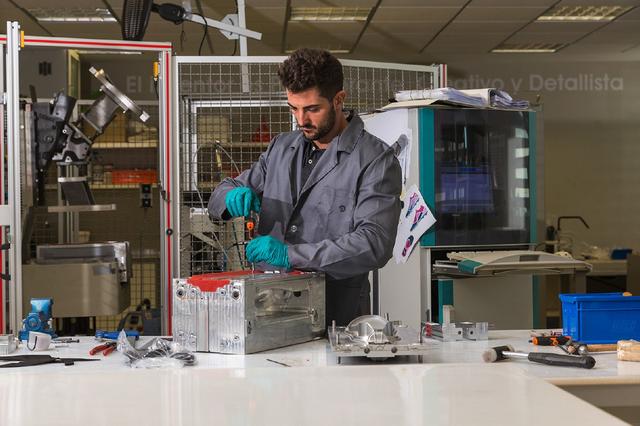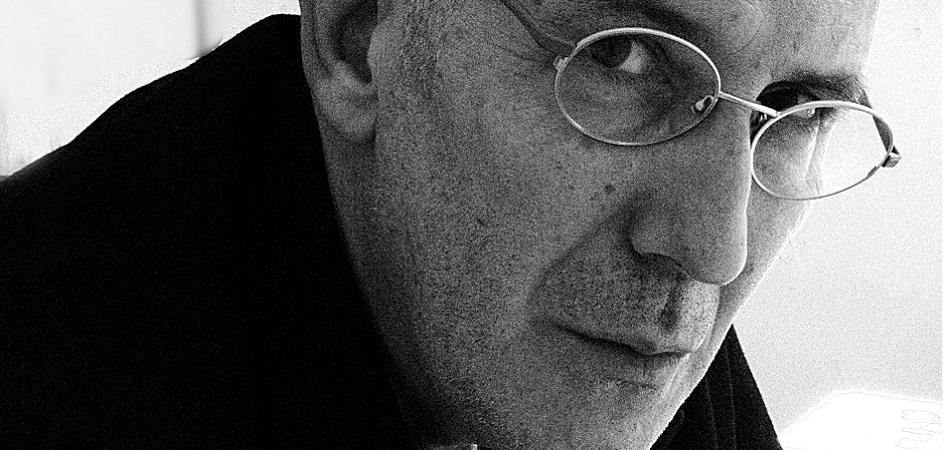Simplicity Works reinvents shoemaking
The entire current Simplicity Works team. | Antonio Amoros
The entrepreneurial gene within him pushed him to create his own collection of children's shoes under the Magus brand, which he sold in boutiques throughout Europe and later set up an advertising agency with which he ended up working for such well-known names as Lodi or Paco Herrero.
Two of the firm's employees work on the design of some models. | Antonio Amoros
It was already the year 2009, in the midst of a crisis, and Hernández kept thinking about a question: How to eliminate the accessory -the need to sew the pieces one by one- from the process of manufacturing a shoe? It is not a minor issue, sewing accounts for approximately 50% of the cost of footwear and the need to make manufacturing cheaper was the main reason for the relocation of a large part of the industry to Southeast Asia in search of cheap labor.
An exodus that reduced national production from around 250 million pairs per year to just over 100 million, and forced companies in the sector to depend on suppliers located on the other side of the world and on the ups and downs of maritime transport.
His experience in footwear production processes made entirely of plastic, such as wellies, ended up giving him the answer, as he crossed one of the Elche bridges, as he recalls. Instead of sewing the pieces one by one, he devised a system that joins all the parts of a shoe at once, after putting them in a mold and injecting a polymer that seals the joints.
A method that not only eliminates the pairing process from the equation, it also replaces the assembly process, which lowers the manufacturing price of each pair by around 70% and allows you to compete face to face with any Asian producer from Europe or American continent.

The system, moreover, is suitable for any material -also for leather footwear- and also has another advantage: the joints are flat, thus avoiding the protrusions caused by the seams inside the shoe and gaining in comfort.
investors
The idea was already clear, but it needed to be developed, probably the most difficult part. Adrián Hernández then had another stroke of luck and met the American chemist, inventor and investor Christopher Banus, who backed the initiative and provided the first 150,000 euros that enabled him to patent his manufacturing system, called 3D Bonding.
After making a round of visits by different footwear technology companies around the world, they also ended up receiving the support of some of them, such as the German Desma, which allowed them to spend four years, from 2013 to 2017, perfecting the system, until the time came to move from the laboratory to the industry.
It was then that another key character joined in this story that is beginning to be successful: the Alcoy businessman Rafael Pascual Bernabeu, owner of Inversiones Industriales Serpis (Aquaclean, Interfabrics, Antecuir), who did not hesitate to invest in the project. The investor and advisor Ezequiel Sánchez, from Binomio Ventures and current coordinator of Distrito Digital, also joined at that time.
But the list of relevant investors does not end there. The managing director of the Ardian fund in Spain, Gonzalo Fernández-Albiñana, or the former CEO of Pikolinos and current executive of Baleària, Georges Bassoul, are other supporters of Simplicity Works, along with the former president of El Corte English and current head of Kapita, Dimas Gimeno, who has already reserved part of the financing round that the firm has underway and with which he wants to raise 2.8 million euros.
In addition, the firm has also received support during this stage of research and development from large firms in the sector, such as Puma or Camper, and has just entered one of the Lanzadera programs, the business accelerator promoted by the owner of Mercadona, Juan Roig.
With the technology ready, Hernández and his team - a staff of twelve people located at the firm's headquarters in the Science Park of the Miguel Hernández University - are already working on the development of the business lines. The main one will be the licenses derived from his patents. In other words, the firm markets its technology for manufacturers to use in exchange for receiving "royalties" for each pair produced with its system.
Thus, the first factory to use 3D Bonding in its mass production has just come into operation in Mexico, in the hands of an important North American multinational that intends to supply part of its needs in this way, without depending on distant Asian factories.
Along with the licenses, the firm will also exploit the design and start-up of the necessary machinery and production lines, of the molds with which the footwear is manufactured or also the design of the shoes themselves.
In this regard, as Hernández explains, the models that will be manufactured with his system are more focused on sports or casual footwear, which is generally exploited with larger print runs, and not so much “early fashion”.
Along with the above, Simplicity Works also wants to exploit direct production for third parties. Thus, it is building its first factory, which will be located in the Elche Business Park, and which, once fully operational, will be capable of producing 400,000 pairs per year. One of its first clients will be the German Wortmann and the firm assures that it already has contracts with several other multinationals, which, yes, for the time being they prefer not to make public. In any case, the firm is convinced that it has initiated the transformation of the way of manufacturing shoes throughout the world.









